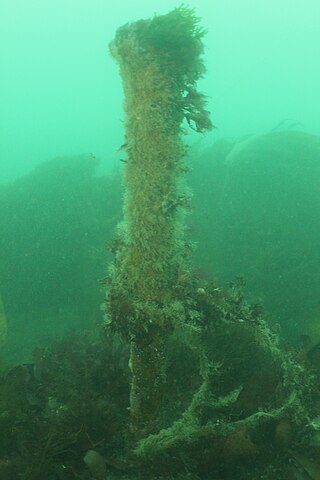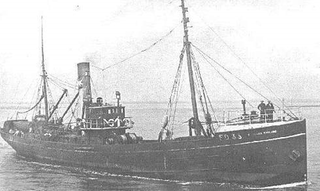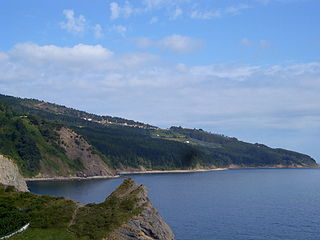
German submarine U-27 was a Type VIIA U-boat of Nazi Germany's Kriegsmarine built for service in World War II. Her keel was laid down in November 1935 in Bremen. She was commissioned in August 1936 with Korvettenkapitän Hans Ibbeken in command. Ibbeken was relieved on 4 October 1937, by Johannes Franz, who commanded the boat until 6 June 1939 when Hans-Georg von Friedeburg assumed command for barely one month. He was relieved on 8 July again by Johannes Franz, who commanded the boat until her loss on 20 September 1939.

Haarlem is a city and municipality in the Netherlands. It is the capital of the province of North Holland. Haarlem is situated at the northern edge of the Randstad, one of the more populated metropolitan areas in Europe; it is also part of the Amsterdam metropolitan area. Haarlem had a population of 162,543 in 2021.
USS Captor (PYc-40), briefly the seventh ship to bear the name USS Eagle (AM-132), was a Q-ship of the United States Navy.

A fishing trawler is a commercial fishing vessel designed to operate fishing trawls. Trawling is a method of fishing that involves actively dragging or pulling a trawl through the water behind one or more trawlers. Trawls are fishing nets that are pulled along the bottom of the sea or in midwater at a specified depth. A trawler may also operate two or more trawl nets simultaneously.

The Arctic Corsair(H320) is a deep-sea trawler, built in 1960, that was converted to a museum ship in 1999. She is temporarily berthed at Alexandra Dock in Kingston upon Hull, England, pending completion of a new permanent location in the city's Museums Quarter. Exhibits and guides aboard the boat tell the story of Hull's deep-sea fishing industry.

German submarine U-33 was a Type VIIA U-boat of Nazi Germany's Kriegsmarine during World War II.

ICGV Óðinn is a decommissioned offshore patrol vessel formerly operated by the Icelandic Coast Guard. She is the oldest ship in the coastguard's fleet, and it is believed that her Burmeister & Wain engines are the only such engines that are still serviceable in the world today. Since her withdrawal from active duty, she has served as a floating exhibit at the Reykjavík Maritime Museum in Reykjavík Harbour. The ship is still maintained, and operative as of June 2022.

Naval trawlers are vessels built along the lines of a fishing trawler but fitted out for naval purposes; they were widely used during the First and Second World Wars. Some, known in the Royal Navy as "Admiralty trawlers", were purpose-built to naval specifications; others were adapted from civilian use. Fishing trawlers were particularly suited for many naval requirements because they were robust vessels designed to work heavy trawls in all types of weather, and had large clear working decks. A minesweeper could be created by replacing the trawl with a mine sweep. Adding depth charge racks on the deck, ASDIC sonar below, and a 3-inch (76 mm) or 4-inch (102 mm) gun in the bow equipped the trawler for anti-submarine duties.

Glen Strathallan was a British ship originally built as a trawler, but then converted into a private yacht, which also served in the Royal Navy in World War II. She was finally scuttled in 1970 at Plymouth Sound, England as a diver training site.
HMT Elk was a 181-ton former fishing trawler built in 1902. She served in the Royal Navy in World War II, until sunk without loss of life having hit a mine off Plymouth in November 1940.

The Viola is a steam trawler built in 1906 in Hull. She is the oldest surviving steam trawler in the world. During her long career, she was known as HMTViola, Kapduen, and Dias. She is currently beached at Grytviken in South Georgia, though there are currently plans afoot to return her to Hull.

Gerdina Hendrika Kurtz (1899–1989) was a Dutch historian, writer and archivist. She published under the name G.H. Kurtz.

Koraaga was a Castle-class steel-hulled trawler built in 1914 by Smith's Dock Company, South Bank, Middlesbrough. She was requisitioned as an auxiliary minesweeper operated by the Royal Australian Navy (RAN) in October 1917 for minesweeping duties during World War I, but she was never commissioned. Koraaga returned to be operated commercially as a fishing trawler until she wrecked when she struck a reef off Bass Point whilst carrying returning to Sydney. She was refloated on the tide after having becoming stranded and drifted till she was finally lost five miles (8.0 km) east of Black Head, Gerringong on 10 September 1931.

The Rudyard Kipling was a British steam trawler launched in 1920 that undertook fishing operations off the coasts of Great Britain and Ireland for almost 20 years. On 16 September 1939, shortly after the outbreak of World War II, the trawler was captured 40 miles (64 km) west of Clare Island by the German submarine U-27. After removing food, equipment, and the crew from the ship, the Germans sunk her with the use of scuttling charges. Several hours later the crew of the Rudyard Kipling were cast adrift 5 nautical miles (9.3 km) off the coast of Ireland. They eventually landed their lifeboats at Killybegs.

Davara was a British steam fishing trawler. Launched in 1912, it was requisitioned in 1914 by the Royal Navy for service in World War I and fitted out as a minesweeper. She was returned to her owners after the war and began service as a trawler once more.
The action of 1 March 1968 was a co-ordinated attempt by four North Vietnamese trawlers to resupply the Viet Cong and the efforts of Operation Market Time elements to stop them during the Vietnam War. On 28 February 1968, United States Navy SP-2H Neptune aircraft on routine patrol detected a North Vietnamese SL class naval trawler heading towards the South Vietnamese coast from north of the DMZ. By the next morning, three more trawlers were discovered and units of Operation Market Time were deployed for a surprise interception. The suspect trawlers did not fly flags so it was not until the start of the engagement that their origin was discovered. The trawlers were steel-hulled vessels, 100 feet long and armed with 57-millimeter recoilless rifles and machine guns. All four vessels were loaded with weapons and ammunition intended to be delivered to the Viet Cong. American and South Vietnamese forces that engaged in action included the United States Coast Guard cutters Androscoggin, Point Grey, Point Welcome, Winona, Point Grace, Point Hudson, Point Marone, the swift boats USS PCF-18, USS PCF-20, USS PCF-42, USS PCF-43, USS PCF-46, USS PCF-47 and USS PCF-48, two South Vietnamese navy junks and one patrol boat. Two U.S. Army helicopter gunships also participated in combat as well as aircraft used to fire flares.

The battle of Cape Machichaco was a naval battle which took place on 5 March 1937 off Bermeo, during the Spanish Civil War, between the Spanish Nationalist heavy cruiser Canarias and four Basque Navy trawlers escorting a Republican convoy. The trawlers were protecting the transport ship Galdames, which was sailing to Bilbao with 173 passengers.
HMT Bradman was a 452-ton anti-submarine warfare trawler of the Royal Navy during the Second World War. She was built by Cochrane & Sons, Selby and was launched on 31 October 1936. As a fishing vessel of the Bunch Steam Fishing company she was registered at Grimsby. In the leadup to the war she was requisitioned by the Admiralty on 26 August 1939 and commissioned into the Royal Navy in October.
On 3 August 1942 the fishing trawler Dureenbee was attacked and badly damaged by Japanese submarine I-175 off the town of Moruya, New South Wales. Three of the trawler's crew were killed, and the ship was subsequently damaged beyond repair after running aground. While the incident has been called a war crime, Allied submarines also conducted similar attacks during World War II.
Junella was a fishing trawler, best known for her service with the Royal Navy during the Falklands War. She was built in 1975 for J Marr & Son, a Hull-based fishing company. On 11 April 1982 she was taken up from trade by the British government and commissioned into the Royal Navy. She was fitted with Second World War era minesweeping gear at Rosyth Dockyard, manned by Royal Navy sailors and allocated to the 11th Mine Countermeasures Squadron. She sailed on 26 April but was unable to commence sweeping until after the 14 June Argentine surrender. In the meantime she was utilised to transfer troops and stores between ships and landed special forces troops at San Carlos. Demining operations commenced on 21 June. Junella returned to the United Kingdom on 11 August, carrying a defused Argentine mine.













